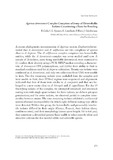Mostrar el registro sencillo del ítem
Agaricus devoniensis complex comprises a group of heterothallic isolates constituting a basis for breeding
| dc.creator | Callac, P. | es_ES |
| dc.creator | Spataro, C. | es_ES |
| dc.creator | Lataillade, E. | es_ES |
| dc.creator | Blasi, P. | es_ES |
| dc.creator | Guinberteau, J. | es_ES |
| dc.date.accessioned | 2018-02-15T10:32:19Z | |
| dc.date.available | 2018-02-15T10:32:19Z | |
| dc.date.issued | 2006 | |
| dc.identifier.isbn | 84-9769-107-5 | |
| dc.identifier.uri | https://hdl.handle.net/2454/27257 | |
| dc.description | Resumen de la conferencia presentada al VI Meeting on Genetics and Cellular Biology of Basidiomycetes (GCBB-VI), organizado por y celebrado en la Universidad Pública de Navarra el 3-6 de junio de 2005. | es_ES |
| dc.description.abstract | A recent phylogenetic reconstruction of Agaricus section Duploannulati revealed that A. devoniensis and A. subfloccosus are two complexes of species close to A. bisporus. The A. subfloccosus complex comprises two homothallic entities, while the A. devoniensis complex was never studied until now. A sample of 26 isolates, some being unreliably determined, were examined to (i) confirm their identity using a PCR-RFLP marker revealing a characteristic A. devoniensis ITS polymorphism, and (ii) for their ability to fruit in standard conditions used for A. bisporus cultivation. Twenty one isolates were confirmed as A. devoniensis, and only two collections from USA were unable to fruit. The five remaining isolates were excluded from the complex and were unable to fruit; their ITS1+2 regions were sequenced and alignments indicated that four of them were similar to A. campestris and that one belonged to a new entity close to A. bitorquis and A. cappellianus. For the 19 fructifying isolates of the complex, we attempted intrastock and interstock mating tests with single spore isolates: for three isolates, we did not get spore germination; and for seven isolates, we observed partial to complete intersterility between strains. The nine remaining isolates exhibited a unifactorial system of sexual incompatibility for which eight different mating type alleles were detected. Within this group, the heterothallic and presumably interfertile isolates differed in their origin (Greece, France), their habitat (dune, coniferous trees), and their morphology (mean spore length: 5.6 to 6.6 μm); they constitute a diversified genetic basis usable to select smooth white and attractive cultivars for this tasteful edible and cultivable species. | en |
| dc.format.extent | 1 p. | |
| dc.format.mimetype | application/pdf | en |
| dc.language.iso | eng | en |
| dc.publisher | Universidad Pública de Navarra / Nafarroako Unibertsitate Publikoa | es |
| dc.relation.ispartof | Antonio G. Pisabarro and Lucía Ramírez (eds.): VI Meeting on Genetics and Cellular Biology of Basidiomycetes (GCBB-VI). Pamplona: Universidad Pública de Navarra / Nafarroako Unibertsitate Publikoa, 2006. | es |
| dc.rights | © Autores; Universidad Pública de Navarra. Esta publicación no puede ser reproducida, almacenada o transmitida total o parcialmente, sea cual fuere el medio y el procedimiento, incluidas las fotocopias, sin permiso previo concedido por escrito por los titulares del copyright. | es_ES |
| dc.subject | Agaricus devoniensis | en |
| dc.title | Agaricus devoniensis complex comprises a group of heterothallic isolates constituting a basis for breeding | en |
| dc.type | info:eu-repo/semantics/conferenceObject | en |
| dc.type | Contribución a congreso / Biltzarrerako ekarpena | es |
| dc.rights.accessRights | info:eu-repo/semantics/openAccess | en |
| dc.rights.accessRights | Acceso abierto / Sarbide irekia | es |
| dc.type.version | info:eu-repo/semantics/publishedVersion | en |
| dc.type.version | Versión publicada / Argitaratu den bertsioa | es |


